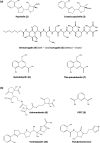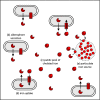Iron acquisition strategies in pseudomonads: mechanisms, ecology, and evolution
- PMID: 36508064
- PMCID: PMC10393863
- DOI: 10.1007/s10534-022-00480-8
Iron acquisition strategies in pseudomonads: mechanisms, ecology, and evolution
Abstract
Iron is important for bacterial growth and survival, as it is a common co-factor in essential enzymes. Although iron is very abundant in the earth crust, its bioavailability is low in most habitats because ferric iron is largely insoluble under aerobic conditions and at neutral pH. Consequently, bacteria have evolved a plethora of mechanisms to solubilize and acquire iron from environmental and host stocks. In this review, I focus on Pseudomonas spp. and first present the main iron uptake mechanisms of this taxa, which involve the direct uptake of ferrous iron via importers, the production of iron-chelating siderophores, the exploitation of siderophores produced by other microbial species, and the use of iron-chelating compounds produced by plants and animals. In the second part of this review, I elaborate on how these mechanisms affect interactions between bacteria in microbial communities, and between bacteria and their hosts. This is important because Pseudomonas spp. live in diverse communities and certain iron-uptake strategies might have evolved not only to acquire this essential nutrient, but also to gain relative advantages over competitors in the race for iron. Thus, an integrative understanding of the mechanisms of iron acquisition and the eco-evolutionary dynamics they drive at the community level might prove most useful to understand why Pseudomonas spp., in particular, and many other bacterial species, in general, have evolved such diverse iron uptake repertoires.
Keywords: Citrate; Diversifying selection; Ferrous iron importer; Heme; Siderophore exploitation and competition; Siderophores.
© 2022. The Author(s).
Conflict of interest statement
The author declares that they have no known competing financial interests or personal relationships that could have influenced the work reported in this paper.
Figures






Similar articles
-
Bacterial siderophores in community and host interactions.Nat Rev Microbiol. 2020 Mar;18(3):152-163. doi: 10.1038/s41579-019-0284-4. Epub 2019 Nov 20. Nat Rev Microbiol. 2020. PMID: 31748738 Free PMC article. Review.
-
A Novel Approach To Identify Inhibitors of Iron Acquisition Systems of Pseudomonas aeruginosa.Microbiol Spectr. 2022 Oct 26;10(5):e0243722. doi: 10.1128/spectrum.02437-22. Epub 2022 Sep 13. Microbiol Spectr. 2022. PMID: 36098531 Free PMC article.
-
Microbial siderophores and their potential applications: a review.Environ Sci Pollut Res Int. 2016 Mar;23(5):3984-99. doi: 10.1007/s11356-015-4294-0. Epub 2015 Mar 12. Environ Sci Pollut Res Int. 2016. PMID: 25758420 Review.
-
Siderophore-mediated iron acquisition and modulation of host-bacterial interactions.Free Radic Biol Med. 2017 Apr;105:68-78. doi: 10.1016/j.freeradbiomed.2016.10.489. Epub 2016 Oct 22. Free Radic Biol Med. 2017. PMID: 27780750 Free PMC article. Review.
-
Pseudomonas aeruginosa and its multiple strategies to access iron.Environ Microbiol. 2023 Apr;25(4):811-831. doi: 10.1111/1462-2920.16328. Epub 2023 Jan 7. Environ Microbiol. 2023. PMID: 36571575 Review.
Cited by
-
Siderophore synthetase-receptor gene coevolution reveals habitat- and pathogen-specific bacterial iron interaction networks.Sci Adv. 2025 Jan 17;11(3):eadq5038. doi: 10.1126/sciadv.adq5038. Epub 2025 Jan 15. Sci Adv. 2025. PMID: 39813347 Free PMC article.
-
The TonB-Dependent Transport System Facilitates the Uptake of Inorganic Metal Mediators in Pseudomonas putida KT2440 in a Bioelectrochemical System.Microb Biotechnol. 2025 Aug;18(8):e70206. doi: 10.1111/1751-7915.70206. Microb Biotechnol. 2025. PMID: 40754734 Free PMC article.
-
Bacterivorous nematodes decipher microbial iron siderophores as prey cue in predator-prey interactions.Proc Natl Acad Sci U S A. 2024 Jan 16;121(3):e2314077121. doi: 10.1073/pnas.2314077121. Epub 2024 Jan 8. Proc Natl Acad Sci U S A. 2024. PMID: 38190542 Free PMC article.
-
Glandular quinoline-derivates protect crustacean woodlice from spider predation.J R Soc Interface. 2025 Aug;22(229):20250260. doi: 10.1098/rsif.2025.0260. Epub 2025 Aug 6. J R Soc Interface. 2025. PMID: 40763796 Free PMC article.
-
Strain identity effects contribute more to Pseudomonas community functioning than strain interactions.ISME J. 2025 Jan 2;19(1):wraf025. doi: 10.1093/ismejo/wraf025. ISME J. 2025. PMID: 39921663 Free PMC article.
References
-
- Albrecht-Gary A-M, Blanc S, Rochel N, Ocaktan AZ, Abdallah MA. Bacterial iron transport: coordination of pyoverdin PaA, a peptidic siderophore of Pseudomonas aeruginosa. Inorg Chem. 1994;33:6391–6402.
Publication types
MeSH terms
Substances
LinkOut - more resources
Full Text Sources
Medical
Miscellaneous

